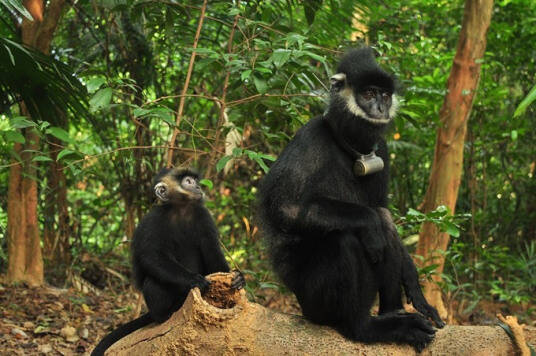Trachypithecus hatinhensis
IUCN
LCBasic Information
Scientific classification
- name:Trachypithecus hatinhensis
- Scientific Name:Trachypithecus hatinhensis,Hatinh Langur,Ha Tinh black leaf monkey
- Outline:Primates
- Family:Monkey genus
Vital signs
- length:50-66cm
- Weight:About 8.7kg
- lifetime:About 20 years
Feature
The face has a distinctive white marking and has a distinct and uniquely shaped crest
Distribution and Habitat
It is found in parts of eastern Laos and the Annamite Mountains in north-central Vietnam.
It inhabits forested areas on steep hillsides, especially in karst limestone areas in parts of Vietnam and Laos. Living on steep, often near-vertical cliffs of karst limestone, such hills can provide the primates with a safe haven from hunting and other human activities. This endangered species lives at altitudes up to 1,500 meters, in trees and on land.
Appearance
The Vietnamese leaf monkey has a head-body length of 50-66 cm, a tail length of 81-87 cm, and a body weight of up to 8.7 kg. It is a leaf monkey with black hair. There is a unique white mark on the face, including some light whiskers, which extend from the corners of the mouth to above the ears and end at the nape of the neck. The fur on the rest of the head is black, with a distinct and uniquely shaped crest. The body fur is very smooth. Newborns are yellow-orange, but this color fades within a few weeks, and by 3 months, it is completely black as an adult monkey.
Details
The Vietnamese black leaf monkey (scientific name: Trachypithecus hatinhensis) is also known as Hatinh Langur in English. It is a monotypic species with no subspecies differentiation. Some primatologists believe that the Vietnamese black leaf monkey is a subspecies of the Laotian black leaf monkey. However, in 2001, the Vietnamese black leaf monkey was identified as an independent species.

The Vietnamese leaf monkey is accustomed to spending the night in caves, crevices and cliff rocks in limestone, while other species of the same genus generally roost in trees. Most Vietnamese leaf monkeys sleep alone, although sometimes they sleep close to each other. The habitat usually faces west or southwest, is heated by the afternoon sun, and seeks shelter from the cold north wind in winter.
The Vietnamese leaf monkey likes to live in groups, with each group usually consisting of 2-15 individuals, and a larger group of about 20 individuals. They usually move and feed in the upper layers of trees, rarely going to the ground. They have certain activity patterns and relatively fixed residences, and their activity range is about 3-5 square kilometers. They are agile and light, good at climbing and jumping, especially active in the morning and evening, and live in natural caves between cliffs at night. They are very vigilant. Before entering the cave at dusk every day, the male monkey who serves as the leader of the group will enter the cave first to observe. When no abnormalities are found, other members will enter in turn. The last to enter the cave are pregnant females with cubs. They live in tropical and subtropical forests, and sometimes in hilly areas. They mainly live in trees. They live in small groups, led by a male monkey, foraging in the morning and afternoon, and resting at noon. They sleep in trees or caves at night.
The Vietnamese leaf monkey is a herbivorous primate that feeds mainly on leaves, flower buds, buds and flowers, wild fruits and seeds. It occasionally eats insects and other small animals. In the rainy season, it drinks water from leaves.
The gestation period of the Vietnamese leaf monkey is 195-210 days, and one baby is born per litter. The lactation period is 12-20 weeks, and the baby becomes more independent from its mother, starts to eat solid food and participate in social activities. Weaning occurs between 7-8 months.
Threats to the survival of the Vietnamese leaf monkey include farmland, grazing, road construction, soil erosion and deforestation, prevention of poisoning caused by crop raiding, and searching for medicine and food. Mainly due to environmental damage causing habitat fragmentation, the species has decreased in number and is endangered.
Listed in the IUCN Red List of Threatened Species in 2016 ver 3.1 - Endangered (EN).
Listed in the CITES Appendix II of the Washington Convention as a protected animal.
Protect wild animals and stop eating game.
Maintaining ecological balance is everyone's responsibility!








